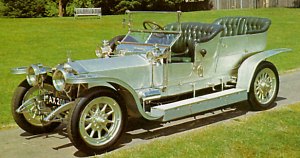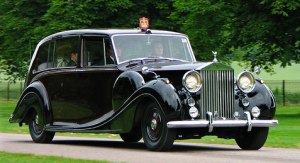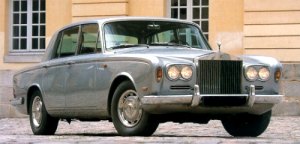
| - |

2022: 6,021 units
2021: 5,586 units
2020: 3,750 units
2019: 5,152 units
2018: 4,107 units
2017: 3,362 units
2016: 4,011 units
2015: 3,785 units (1,609 Ghosts, 488 Phantoms, 1,688 Wraiths)
2014: 4,063 units (1,555 Ghosts, 602 Phantoms, 1,906 Wraiths)
2013: 3,630 units
2012: 3,575 units
2011: 3,538 units
2010: 2,711 units (2,174 Ghosts, 351 Phantoms, 186 Coupes / Drophead Coupes)
2009: 1,002 units (376 Phantoms, 261 Drophead Coupes, 198 Phantom Coupes, 167 Ghosts)
2008: 1,212 units
2007: 1,010 units (757 Phantoms, 253 Drophead Coupes)
2006: 847 units
2005: 796 units
2004: 792 units
2003: 300 units
Compare to Volkswagen's approach to Bentley, BMW's plan for Rolls-Royce is more loyal to the core values of RR. It maintained the market positioning, the styling and character of traditional Rolls-Royce. However, the conservative approach resulted in less sales than expected. Today it is still searching for ways to return the investment made by its parent company.
 1907 Silver Ghost
1907 Silver GhostThe Silver Ghost was described as the best car in the world then. As a principle of Henry Royce, RR always made cars as strong as possible without worrying weight, size and price. In addition to the superb craftsmanship, the company achieved a reputation as making the best luxury cars in the world.
Approaching the 1930s, RR’s superior status was challenged by Bentley 8-Litre, a luxury car with size, power and everything to worry the contemporary Rolls-Royce Phantom II. Nevertheless, the great depression in 1930s put Bentley into bankruptcy and RR seized the chance to acquired its rival. Since then Rolls-Royce dictated the development of Bentley cars and eventually made the latter re-badged versions of Rolls-Royce.
 1950 Phantom IV serving the Royal family
1950 Phantom IV serving the Royal familyDuring both World Wars, Rolls-Royce produced a large number of aero engines to serve the war planes of Allies. Its aero engine division continued in the jet era, powering jet fighters as well as Boeing 747 etc. On the contrary, the car division gradually lagged behind the competition in design and technology. Although it was still proud of traditional craftsmanship, its cars looked increasingly outdated after the Second World War. This declining trend was finally stopped by the 1965 Silver Shadow, which brought the company's first monocoque chassis, independent rear suspensions and disc brakes. The car also introduced a modern exterior design, in contrast to the previous Rolls-Royces that could be traced back to the pre-war years. It set an all-time company sales record with 38,000 units sold during its 15 years life.
In 1971, the car division of Rolls-Royce was seperated from the aero engine division under the guidance of the British government. They became Rolls-Royce Motor Cars and Rolls-Royce Plc respectively. Rights to the Rolls-Royce trademark went to the aero engine company, but licensed to the car company for use.
 1965 Silver Shadow
1965 Silver ShadowIn 1980, Rolls-Royce Motor Cars was acquired by military tank maker Vickers.
Entering 1990s, Rolls-Royce established a link with BMW by using its technologies - the 1998 Silver Seraph employed BMW's V12 engine and other components consisting 30% of the whole car. BMW CEO Bernd Pischetsrieder was interested to buy Rolls-Royce in order to complement for its lack of ultra-luxury cars. In 1998, Pischetsrieder finally made an offer to Vickers, but he was soon shocked that Volkswagen group stole the deal with an even better offer. It was later known that Ferdinand Piech was more interested in Bentley and the Crewe factory rather than the Rolls-Royce brand. BMW fought back by securing the rights of Rolls-Royce name from Rolls-Royce Plc, thanks to the business relationship between BMW's aero engine division and Rolls-Royce Plc. Eventually, Pischetsrieder and Piech settled on an agreement that the Bentley brand name and the factory would go to VW, while the Rolls-Royce marque would transfer to BMW from the beginning of 2003. In this way, Rolls-Royce and Bentley parted ways after more than 70 years together.
Unsurprisingly, during the 4 years management under Volkswagen, the Rolls-Royce brand was put into low gear and the focus was shifted to Bentley. Meanwhile, BMW worked on a new Rolls-Royce called "Phantom" - the first RR engineered by German. To preserve its Britishness, BMW built a new Rolls-Royce factory in Goodwood of England to produce the car. The marque was finally handed over to BMW on the 1st of January, 2003.